
Arctic Ocean is the smallest of all oceans. It is almost the size of Russia and is also very shallow with an average depth of just 987 metres. Its name is derived from the Greek word “Arktos” which means ‘bear’. It was named so because the Bear constellation was right above the North Pole.
Arctic Ocean is the only ocean which is almost surrounded by landmasses. North America, Eurasia and Greenland are the major landmasses that share a coastline with the Arctic Ocean. Its shelves extend for a normal width of 96 to 190 kilometres in North Alaska and Greenland. The Siberian and Chukchi shelves of Eurasia are the widest with a width of 480 to 1770 kilometres. The countries that surround the Arctic Ocean are Canada, United States, Denmark, Greenland, Norway, Russia and Iceland.
Being the smallest of all the oceans, it covers an area slightly more than 14 million square kilometres. It is nearly six times the size of the largest sea, the Mediterranean Sea. Apart from being the smallest, it is also a very shallow ocean with an average depth of only 987 metres and the deepest point lies in the Eurasia Basin at 5,500 metres below the sea level.
Yes, there is an enormous underwater mountain in the Arctic Ocean known as Lomonosov Ridge, named after the scientist, poet and grammarian Mikhail Vasilvevich Lomonosov, which runs for nearly 1,770 kilometres from Ellesmere Island – Canada, to the New Siberian Islands – Russia, and a width that ranges from 64 to 193 kilometres. It stands more than 3,000 metres above the sea bed and divides the ocean into two deep basins, viz. the Eurasia Basin which is on the European side and the Amerasia Basin which is on the American side. The peak of the ridges rises up to a height of 1800 to 3400km above the basin floor.
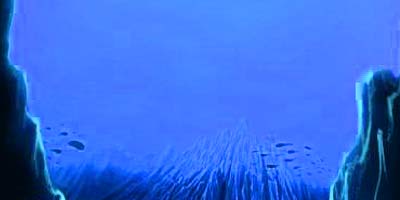
The water mass of Arctic Ocean is divided into three masses.
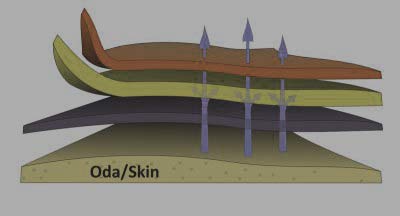
The first would be the water mass from the surface till the depth of 198 metres. The temperature of this water mass ranges at around -13°C and has a salinity ranging from 28 to 34g of salt per kilogram of sea water.
There is another layer of a little warmer sea water at a depth between 198 metres and 914 metres with a temperature of about 1 to 3°C and as it cools down it enters the basin with a further decline in the temperature. Salinity increases as well to 34 to 35g of salt per kilogram of sea water.
Below this layer, the water that extends till the ocean floor has a colder temperature i.e. below 0°C but the salinity remains same. This is the large quantity of the Atlantic water that has flowed under the Arctic water.
The entire surface of the Arctic Ocean remains almost covered with sea ice. Especially above the latitude of 75°N where there is a permanent ice cover, and between 60°N and 75°N there is a seasonal sea ice while its rare below the latitude 60°N. The more the water froze into ice, the salinity also decreased. The newly formed ice has 4-6 grams of salt per kilogram of sea water. As long as the sea ice stayed on the surface, the thickness increased and the salinity decreased. By the time it is a year old, the ice became salt-free and if melted it can be used for drinking. At the same time, the hardness and the thickness increases since the salt is expelled and thus a year-old ice is nearly 2 metres thick and a more aged ice has an average thickness of 4 metres.
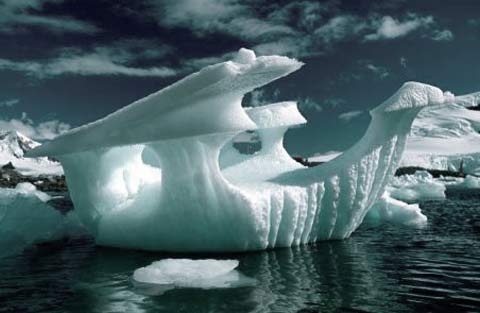
Arctic Ocean has three kinds of sea ice, viz. polar ice, pack ice and fast ice. Polar ice is usually 2 metre thick during summer and 50 metre thick in winter. This raft of ice never melts throughout the year. The pack ice is formed after the broken ice pieces are carried by ocean currents and joined together to form a single mass. Sometimes these pack ice form spectacular ice sculptures in oceans. Fast ice is fixed strongly to the land and it doesn’t move up and down with the ocean current or the wind.
The species that live in Arctic Ocean are capable of surviving in the extreme cold conditions. Some of the major mammals that reside in this ocean are:
-
Walruses- The average male weighs 1900 kg and an average female weighs 1200 kg. They have a robust body which is gray-brown or cinnamon brown. They also have long and strong pair of tusks as well.
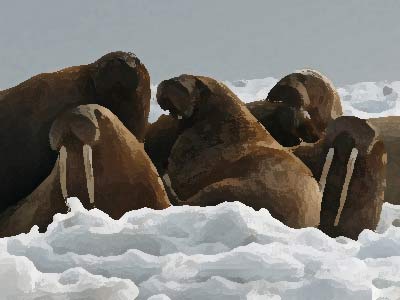
- Ringed Seal - An average adult ringed seal has a body length of up to 1.65 metre and weighs up to 70 kg. They have black spots with gray rings on their body. They eat mostly fishes and zooplanktons but they don’t have ears.
- Beluga whale- This is one of the smallest species of whales. Its length ranges from 4 to 6.1 metre and has a weight of nearly 1300 kg. It is also known as the white whale but they are born grey or even brown which later turns white after five years.
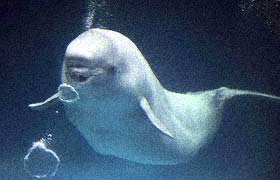
As any other ocean, Arctic Ocean also has planktons, seaweeds, moss etc. as water plants.
Compared to other oceans, the Arctic Ocean has a lesser number of islands. Few of the major islands of Arctic Ocean are:
- Svalbard- It is actually a group of islands located between 74° to 81°N latitude and 10° to 35°E longitude.This group of islands lie to the northeast of Norway and was formerly known as Spitsbergen. These islands experience midnight sun for 99 days i.e. the sun is visible during midnight, and polar night for 84 days i.e. during these days the sun stays below the horizon.
- Franz Josef Land- This is also a group of islands but the number of islands counts up to 191. The islands have an average temperature of -22°C in winter and 2°C in summer. Polar bears, the Arctic Fox, walrus, seal can be found here.
- The New Siberian Islands- This is also an archipelago- a group of islands. It is located to the northeast of Russia and north of Siberia. It covers a total area of around 38,000 sq.km.
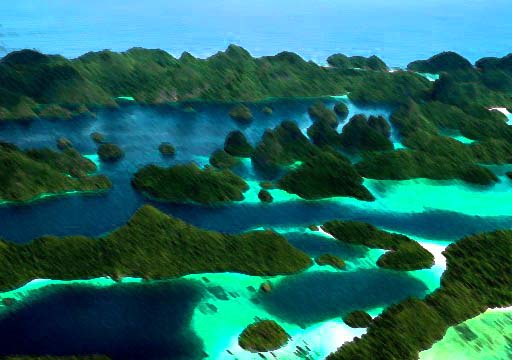
The major seas that flow into the Arctic Ocean are the Barents Sea, Kara Sea, Laptev Sea, Chukchi Sea, Beaufort Sea, Wandel Sea, Lincoln Sea, Open Polar Sea, East Siberian Sea, Greenland Sea and Pechora Sea. The largest among these seas is the Barents Sea with an area of 1,405,000 sq km. Apart from the seas few other major water bodies in the Arctic Ocean are Hudson Bay, Baffin Bay and Davis Strait.


